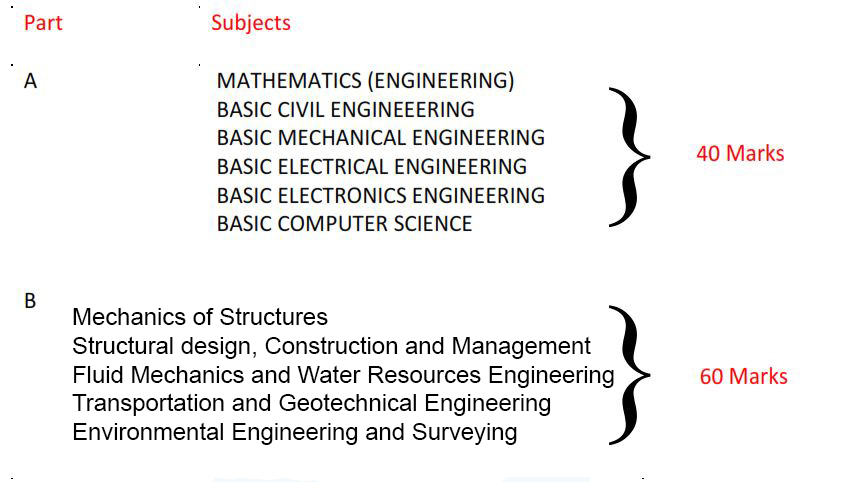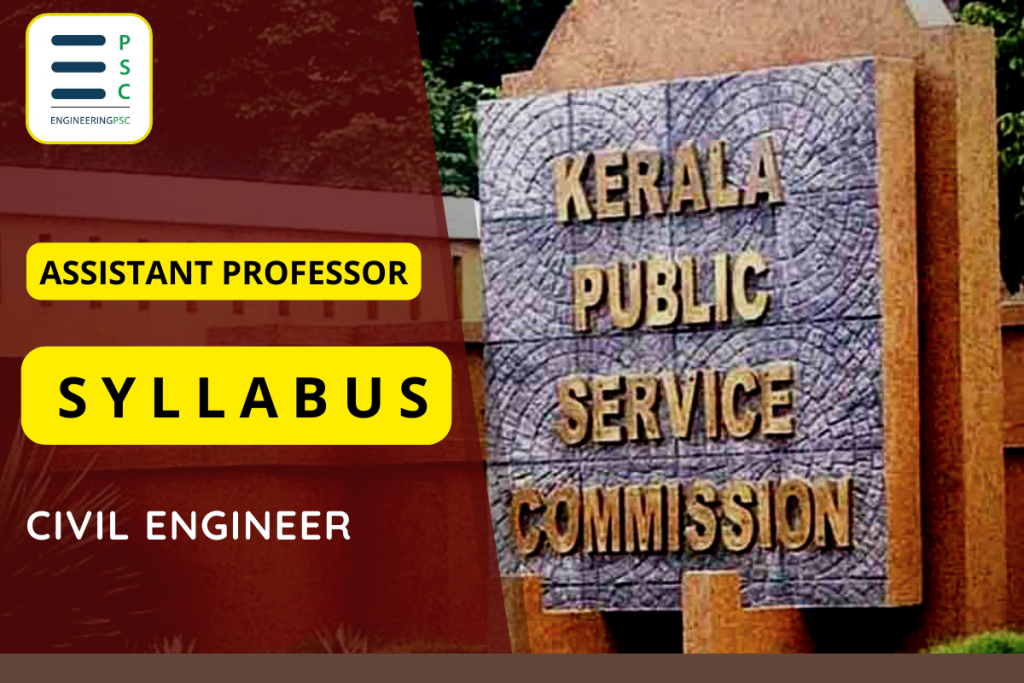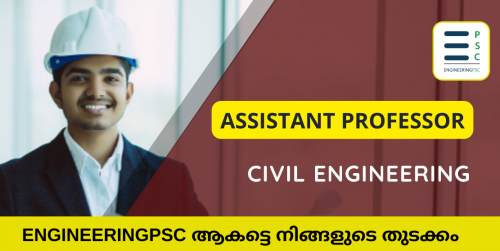
Assistant professor in government engineering college exam published in 2022. The syllabus comprises of two parts as given below

- Mode of Exam: MCQ (OMR)
- Exam contains 100 Questions
- Each correct answer carry one mark & 0.33 detected for wrong answers
- Total time allotted : 1hr 15 min
Do you believe that all questions comes from the syllabus ?
NO, Thorough knowledge of subject is required since question from outside can be expected. In the recent years we can see a trend of deviation in questions in the technical exams conducted by the Kerala PSC.
Will only studying topics in syllabus fetch me a GOVT Job?
Do not blindly follow the syllabus rather have good technical knowledge of your subjects. If you check the previous year papers you could find out many questions coming outside the syllabus in all technical exams by Kerala PSC.

Assistant Professor in
COMPUTER SCIENCE ENGINEERING SYLLABUS
*Non Technical portions has been omitted from the syllabus
MATHEMATICS (ENGINEERING)
Matrices: Rank, systems of linear equations, consistency, eigen values, eigen vectors, Cayley Hamilton Theorem, diagonalisation, linear dependence and independence of vectors.
Demo Class : Click Here
Partial Differentiation: Partial derivatives, Euler’s theorem on homogeneous functions, total derivatives, Jacobians, Taylor’s series (one and two variables) – Maxima and minima of functions of two variables – Lagrange’ s method.
Vector Differentiation: Scalar and vector functions, differentiation of vector functions – velocity and acceleration – scalar and vector fields – operator Ñ – Gradient – Directional derivative – Divergence – Curl – irrotational and solenoidal fields – scalar potential.
Laplace Transforms: Transforms of elementary functions, shifting property – inverse transforms – transforms of derivatives and integrals – transform of functions multiplied by t and divided by t – convolution theorem, solution of ordinary differential equations with constant coefficients using Laplace transforms.
Ordinary Differential Equations: First Order ordinary differential equations, systems of linear first order ordinary differential equations, linear ordinary differential equations of higher order with constant coefficients, linear second order ordinary differential equations with variable coefficients (Cauchy and Legendre equations), Method of Laplace transforms for solving ordinary differential equations.
Complex Analysis: Analytic functions, conformal mappings, bilinear transformations, complex integration, Cauchy’s integral theorem and formula, Taylor and Laurent’s series, residue theorem.
Fourier Series: Fourier series of periodic functions of period 2 π and 2 ℓ, odd and even functions, Half range expansions.
BASIC CIVIL ENGINEEERING
Mechanics – statistics – Coplanar forces – conditions of equilibrium. Support reactions – Simply supported and overhanging beams. Friction – Laws of friction – applications. Centre of gravity and moment of inertia of plane areas. Dynamics – rectilinear motion – Newton’s laws of motion – curvilinear motion.
Building materials – common building materials – stone, brick, cement, steel, aggregate, concrete, timber – properties, IS specification. Building construction – types and functions of the following structural components of buildings – foundations and superstructure.
Surveying – principle of surveying – linear measurements using chain – levelling work – reduction of levels.
Demo Class : Click Here
BASIC MECHANICAL ENGINEERING
Zeroth, first and second laws of thermodynamics, CI and SI Engines, properties of steam. Centrifugal and reciprocating pumps, hydraulic turbines, refrigeration and air conditioning, hydro-electric, thermal and nuclear power plants, mechanical power transmission systems such as belt, rope, chain and gear, manufacturing process – casting, forging, rolling, brazing, soldering, and welding, machining process – turning, shaping, drilling, grinding and milling. Conic sections and miscellaneous curves, orthographic, isometric and perspective projections.
Demo Class : Click Here
BASIC ELECTRICAL ENGINEERING
Ohm’s law, Kirchoff’s laws – solution of series and parallel circuits with dc excitation.
Magnetic circuits: MMF, field strength, flux density, reluctance, electromagnetic induction, Faraday’s laws, Lenz’s law, statically and dynamically induced emfs, self and mutual induction, co-efficient of coupling.
Principle of generation of alternating current – waveforms – frequency, period, average and rms values, form factor.
Generation of 3 phase ac voltage, star and delta connections, voltage & current relationships in star and delta (balanced system only). Principle of operation of dc motor & generator, single phase transformer and three phase induction motor.
Types of lamps, necessity of earthing.
BASIC ELECTRONICS ENGINEERING
Devices – working principle of PN junction, Zener diode and BJT.
Systems – Rectifiers : Half wave, Full wave and Bridge. Filters: Capacitors and
Inductors.
Amplifiers & Oscillators – Common Emitter RC coupled amplifier and its frequency response. Principles of Wein-bridge oscillator. Op-amps: Basics, inverting and non- inverting amplifier.
Communication – Need for modulation, principles of AM and FM. Measurements – Working principles of CRO and Multimeter.
BASIC COMPUTER SCIENCE
Functional units of a computer.
Programming in C – control structures, functions.
Mechanics of Structures
Simple stress and strain relationship: Stress and strain in two dimensions, principal stresses, Stress transformation, Mohr’s circle – Bending moment and shear force in statically determinate beams – Simple bending theory, flexural and shear stress – Thin walled pressure vessels, uniform torsion, buckling of column, combined and direct bending stresses.
Analysis of statically determinate trusses, arches, beams, cables and frames – Deflection of beams, methods – Displacements in statically determinate structures and analysis of statically indeterminate structures by force / energy methods, analysis by displacement methods (slope deflection and moment distribution methods) – influence lines for determinate and indeterminate structures – Basic concepts of matrix methods of structural analysis.
Demo Class : Click Here
Structural design, Construction and Management
Concrete Structures – Concrete technology – properties of concrete, mix design. Concrete design – working stress and limit state design concepts – analysis of ultimate load capacity and design of members subjected to flexure, shear, compression and torsion by limit state methods. Basic elements of pre-stressed concrete, analysis of beam sections (rectangular and I sections). Design of retaining walls and water tanks. Steel structures – Analysis and design of tension and compression members, beams, beam-columns, column bases. Connections – simple and eccentric beam column connections – plate girders and trusses – Plastic analysis of beams and frames. Construction Management – Construction, planning and scheduling – Bar chart, CPM, PERT – construction equipments – construction procedures – contract, tender documents.
Building Planning – building bye laws – functional planning of buildings.
Building materials and construction – construction materials, properties, IS
specifications, prefabricated structural elements.
Quantity surveying & valuation – Building construction – detailed specification, preparation of data and analysis of rates for various items of work. Type of estimates
– Detailed estimate for buildings. Valuation methods.
Demo Class : Click Here
Fluid Mechanics and Water Resources Engineering
Fluid mechanics and Hydraulics – Properties of fluids, Principle of conservation of mass, momentum, energy and corresponding equations, potential flow, applications of momentum and Bernoulli’s equation, laminar and turbulent flow, flow in pipes – flow
in open channels – uniform flow, critical flow and gradually varied flow, specific energy concept, hydraulic jump. Forces on immersed bodies, flow measurement in channels, tanks and pipes. Dimensional analysis and hydraulic modelling, kinematics of flow, velocity triangles and specific speed of pumps and turbines.
Hydrology and water Resources – Hydrologic cycle – rainfall, evaporation, infiltration, unit hydrograph. Reservoir capacity, well hydraulics.
Irrigation – duty, delta, crop water requirements – Design of lined and unlined canals
– canals on alluvium, head works, gravity dams and spillways. Design of weirs on permeable foundations – Canal Head works, cross drainage works.
Demo Class : Click Here
Transportation and Geotechnical Engineering
Soil mechanics – soil classification, three phase system, fundamental definitions, relationship and interrelationships, permeability and seepage, effective stress principle, consolidation, compaction, shear strength.
Foundation Engineering – subsurface investigations – drilling bore holes, sampling, penetration lists, plate load test. Earth pressure theories, effect of water table, layered soils. Stability of slopes, infinite slope, finite slope. Foundation types – foundation design requirements. Shallow foundations – bearing capacity, effect of shape, water table and other factors, stress distribution, settlement analysis in sand and clay. Pile foundations, types, dynamic and static formula load capacity of files in sand and clay, negative skein friction.
Highway Engineering – Geometric design of highways, testing and specifications of paving materials, design of flexible and rigid pavements. Traffic Engineering – Traffic characteristics – theory of traffic flow, intersection design, traffic signs and signal design, highway capacity.
Railway Engineering – points and crossing – signalling stations and yards.
Harbour Engineering – classification – requirement and site selection – break waters –
classification – docks, functions and types of docks.
Tunnelling – Transfer of centre line – methods of construction on rocks and soils, tunnel lining, ventilation, lighting and drainage.
Airport – planning and design – characteristics, component parts – site selection –
runway design.
Environmental Engineering and Surveying
Water requirements: Quality standards, basic unit processes and operation for water treatment. Drinking water standards, water requirements, basic unit operations and unit processes for surface water treatment, distribution of water sewage and sewerage treatment, quantity and characteristics of waste water. Primary, secondary and tertiary treatment of wastewater, sludge disposal, effluent discharge standards. Domestic waste water treatment, quantity and characteristics of domestic wastewater, primary and secondary treatment. Unit operations and unit processes of domestic wastewater, sludge disposal.
Surveying: Importance of surveying, principles and classification, measurement of distances and directions, levelling, contouring, computation of areas and volumes, traversing, theodolite and plane table. Errors and adjustments, curves – vertical and horizontal.
Tacheometric survey – Stadia and tangential systems.
Photogrammetry – Heights and distances – vertical photograph – Relief displacement. Total station – types. Working principles – measurement techniques.
Hydrographic survey.
Reference : Click Here

